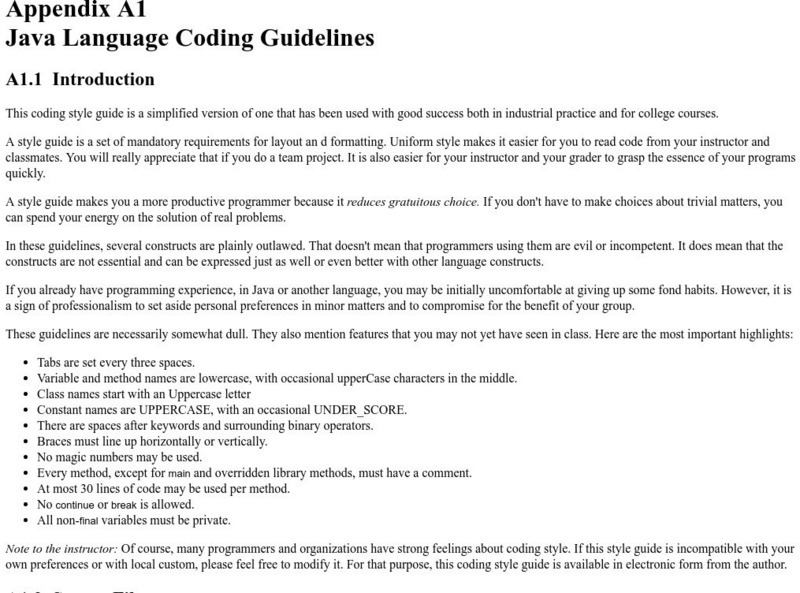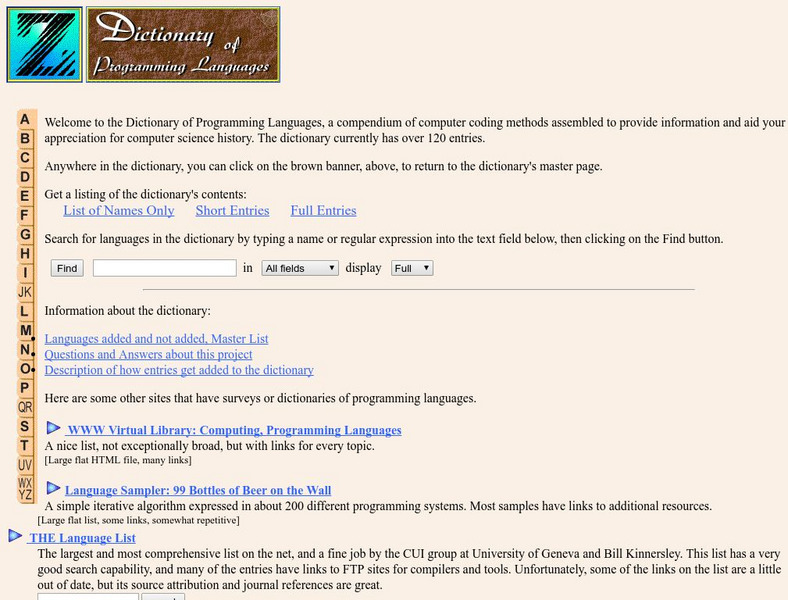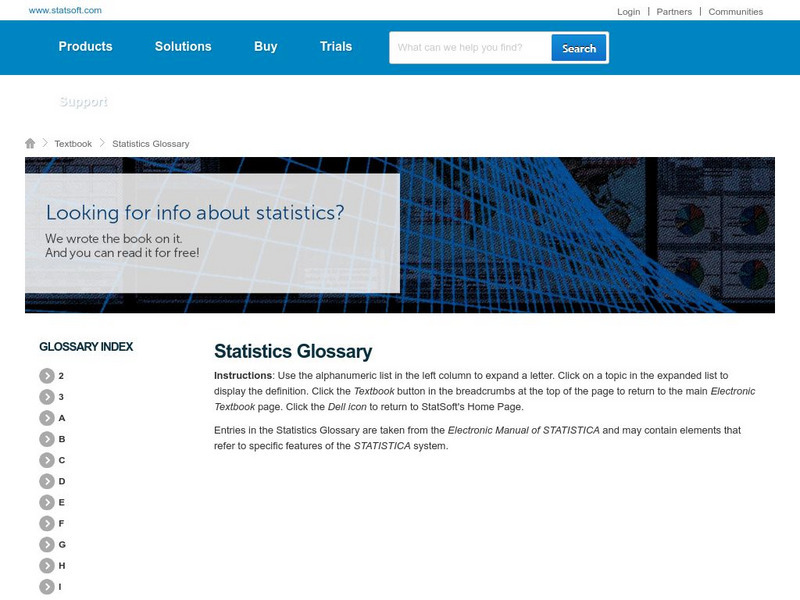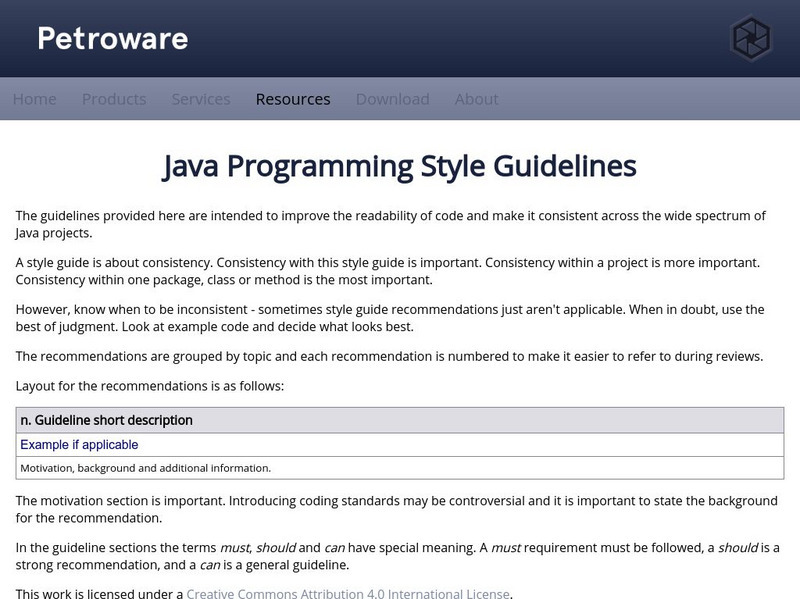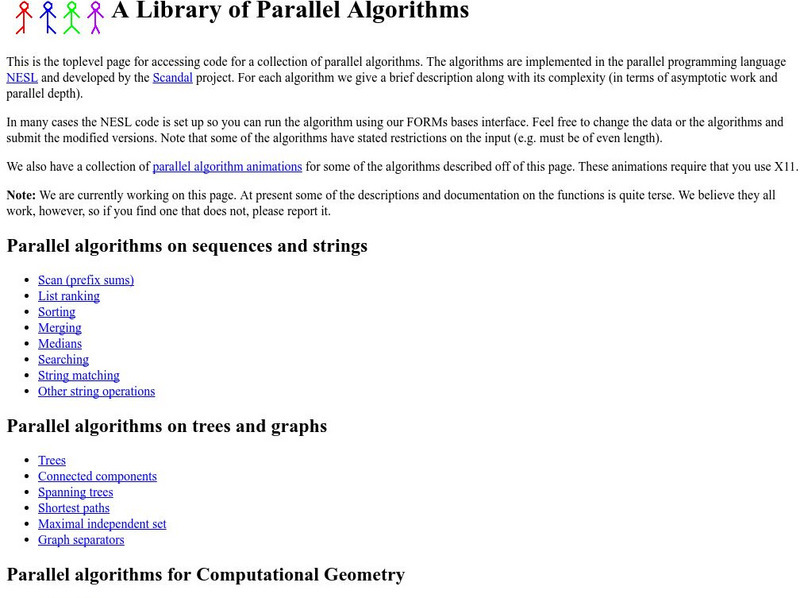Code.org
HTTP and Abstraction on the Internet
Introduce your class to the layers of abstraction of the Internet with a lesson on the HTTP protocol. Pupils review previous lessons on levels of the Internet, then investigate new high levels by examining the HTTP traffic on...
TryEngineering
Data Representation: Millions of Colors
How many colors do you know? The lesson teaches scholars how digital devices use binary and hexadecimal representations to store colors. They learn how millions of colors are available on these devices.
Classroom Law Project
What do cartoonists see in this election?
Cartoons from the 2008 Presidential election provide the text for a lesson designed to help learners understand how political cartoonists use persuasive techniques to present a point of view.
Other
Horstmann: Java Language Coding Guidelines
A coding style guide for the Java programming language that has been used successfully in education and industry alike.
Other
Le Code Navajo
In French, read about the Navajo specialists who used their language to help defeat the Japanese in WWII. These Native Americans saved 1000s of lives with their spy code skills.
University of Hawai'i
University of Hawaii: Business Editors Ethics Code
The official ethics code of The Society of American Business Editors and Writers provided for by the University of Hawaii.
City University of New York
Bio Lab Module: Breaking the Genetic Code
Try this interactive module from the Brooklyn College to help understand the genetic code and how changes in the code effect the final protein product.
Texas State Library and Archives Commission
Texas State Library and Archives Commission: The 1890s: Black Codes
Here is a brief description of Black Codes, which were set in place in Texas in 1866 and "outlined a status for African Americans not too much removed from their earlier condition as slaves."
Intel Corporation
Intel Education: Lesson 1: What Is Binary Code?
A short description of binary numbers and how they work.
Nobel Media AB
The Nobel Prize: How to Crack the Code
Through a series of illustrations, learn about the physical carriers of inheritance. Discover facts about DNA, the blueprint of life, and RNA, the blueprint copy.
Other
Ziring Micro Web: Dictionary of Programming Languages
A compendium of computer coding methods assembled to provide information and aid your appreciation for computer science history. The dictionary currently has over 120 entries which are searchable in various ways.
PBS
Pbs News Hour Extra: The Human Genome Project, a Decade Later
This article reviews advances made by medical researchers since the complete mapping of the human genetic code ten years earlier. Although the expectation then had been that cures could be found for many diseases based on this new...
PBS
Pbs Learning Media: Journey Into Dna
Travel deep into the human body to see exactly where your DNA resides. From the NOVA: Cracking the Code of Life Web site.
Texas State Library and Archives Commission
Texas State Library and Archives Commission: The 1890s: End of an Era and the Quest for Civil Rights
Part of an online exhibit called "Forever Free," this section deals with African Americans' efforts to establish themselves in society, despite increases in racism. Addresses topics such as Black Codes, Jim Crow Laws, and voting rights.
Massachusetts Institute of Technology
Mit: Inventor of the Week: Samuel f.b. Morse
Provides a short biography of Samuel F.B. Morse, and his invention of the one-wire telegraph and the Morse Code. Also contains pictures.
Other
Stat Soft: Statistics Glossary
Dozens of statistical terms are defined and illustrated in this glossary.
PBS
Pbs Learning Media: Genome Facts
This list from NOVA: "Cracking the Code of Life" Web site provides some of the basic, yet impressive, facts and figures about the Human Genome Project.
Other
Geotechnical Software Services : C++ Programming Style Guidelines
This site describes the C++ coding recommendations that are common in the C++ development community.
Other
Geotechnical Software Services : Java Programming Style Guidelines
This site describes Java coding recommendations that are common in the Java development community.
PBS
Pbs Learning Media: Nature Versus Nurture Revisited
Which dictates our existence? Is it our genetic makeup or the environment we grow up in? Kevin Davies offers an update on this long-standing debate, from the NOVA: "Cracking the Code of Life" Web site.
Carnegie Mellon University
Carnegie Mellon: A Library of Parallel Algorithms
A page for accessing code for a collection of parallel algorithms.The algorithms are implemented in the parallel programming language NESL and developed by the Scandal project. There is a brief description along with its complexity (in...
City University of New York
Brooklyn College: Genotype and Phenotype
In this informative site, you will find the definition of genotype and phenotype, an explanation of the relationship between genotype and phenotype, an example of a genetic trait, an explanation of the flow of information from DNA to...
University of Hawai'i
University of Hawaii: Bubble Sort
This page explains how a bubble sort works along with examples and source code.
Countries and Their Cultures
Countries and Their Cultures: Assyrians
Ancient Assyrians were inhabitants of one the world's earliest civilizations, Mesopotamia, which began to emerge around 3500 B . C . The Assyrians invented the world's first written language and the 360-degree circle, established...



